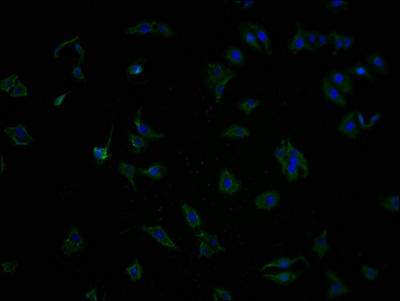Description
| Antibody Name: | OR5T2 Antibody (PACO64415) |
| Antibody SKU: | PACO64415 |
| Size: | 50ul |
| Host Species: | Rabbit |
| Tested Applications: | ELISA, IF |
| Recommended Dilutions: | IF:1:100-1:500 |
| Species Reactivity: | Human |
| Immunogen: | Peptide sequence from Human Olfactory receptor 5T2 protein (298-310AA) |
| Form: | Liquid |
| Storage Buffer: | Preservative: 0.03% Proclin 300 Constituents: 50% Glycerol, 0.01M PBS, PH 7.4 |
| Purification Method: | >95%, Protein G purified |
| Clonality: | Polyclonal |
| Isotype: | IgG |
| Conjugate: | Non-conjugated |
 | Immunofluorescence staining of HepG2 cells with PACO64415 at 1:100, counter-stained with DAPI. The cells were fixed in 4% formaldehyde and blocked in 10% normal Goat Serum. The cells were then incubated with the antibody overnight at 4°C. The secondary antibody was Alexa Fluor 488-congugated AffiniPure Goat Anti-Rabbit IgG(H+L). |
| Background: | Odorant receptor. |
| Synonyms: | Olfactory receptor 5T2 (Olfactory receptor OR11-177), OR5T2 |
| UniProt Protein Function: | OR5T2: Odorant receptor (Potential). Belongs to the G-protein coupled receptor 1 family.Protein type: Membrane protein, integral; Membrane protein, multi-pass; GPCR, family 1; Receptor, GPCRChromosomal Location of Human Ortholog: 11q12.1Cellular Component: integral to membrane; plasma membraneMolecular Function: G-protein coupled receptor activity; olfactory receptor activityBiological Process: G-protein coupled receptor protein signaling pathway; detection of chemical stimulus involved in sensory perception of smell |
| UniProt Protein Details: | |
| NCBI Summary: | Olfactory receptors interact with odorant molecules in the nose, to initiate a neuronal response that triggers the perception of a smell. The olfactory receptor proteins are members of a large family of G-protein-coupled receptors (GPCR) arising from single coding-exon genes. Olfactory receptors share a 7-transmembrane domain structure with many neurotransmitter and hormone receptors and are responsible for the recognition and G protein-mediated transduction of odorant signals. The olfactory receptor gene family is the largest in the genome. The nomenclature assigned to the olfactory receptor genes and proteins for this organism is independent of other organisms. [provided by RefSeq, Jul 2008] |
| UniProt Code: | Q8NGG2 |
| NCBI GenInfo Identifier: | 52317142 |
| NCBI Gene ID: | 219464 |
| NCBI Accession: | NP_001004746.1 |
| UniProt Secondary Accession: | Q8NGG2,Q6IFC8, B9EGX5 |
| UniProt Related Accession: | Q8NGG2 |
| Molecular Weight: | 40,696 Da |
| NCBI Full Name: | olfactory receptor 5T2 |
| NCBI Synonym Full Names: | olfactory receptor, family 5, subfamily T, member 2 |
| NCBI Official Symbol: | OR5T2 |
| NCBI Official Synonym Symbols: | OR11-177 |
| NCBI Protein Information: | olfactory receptor 5T2; olfactory receptor OR11-177 |
| UniProt Protein Name: | Olfactory receptor 5T2 |
| UniProt Synonym Protein Names: | Olfactory receptor OR11-177 |
| Protein Family: | Olfactory receptor |
| UniProt Gene Name: | OR5T2 |
| UniProt Entry Name: | OR5T2_HUMAN |






